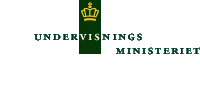
Chapter 3
PERSPECTIVES
Based on lectures held at the “On the Threshold – Baltic 21” conference in Sønderborg, Denmark in June 2000, summarised by journalist Bjarke Larsen, Denmark
Baltic 21: An Agenda 21 for the Baltic Sea Region - with special
reference to the agricultural sector
Lecture by Christine Jakobsson, Sweden
“Baltic 21 is an overall framework for regional co-operative efforts in promoting sustainable development,” Christine Jakobsson said, “and the Baltic Sea Region is the only region in the world which has adopted a common fisheries policy with quotas which works,” she continued, giving an example of the work being carried out.
She told the audience that work within the sectors encompassed by Baltic 21 is being carried out with two countries at the forefront –one from Eastern Europe and one from Western Europe – or by a common organisation.
Within each sector as well as across all sectors, a string of joint actions are being implemented. Among the most important, Christine Jakobsson mentioned increased production and use of bioenergy and other renewable energy sources, plus the establishment of demonstration areas and pilot projects for proving sustainable development in practice.
“Here you can show people the effects of different experiments and form a basis to discuss the pros and cons of various ways of trying to reach the common goals,” she said.
Another important joint action is to get cities to work together when buying different kinds of things: “Did you know that 65% of all decisions on what to buy – and where – within the public sector are taken at community level?” she asked. “This means that it is very important to raise the awareness of sustainable development on this level.” As an example of how this can be done successfully, she mentioned traffic lights. Some years ago, a public contest was held in this area resulting in a new kind of traffic lights, which shine brighter but use less electricity than the ’old fashioned’ kind.
Where the circles meet
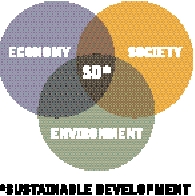
Sustainable development is where the three circles – economy – society - environment - overlap
Christine Jakobsson underlined the importance of not just working with the environment when talking about sustainable development. Economic sustainability and social sustainability are of equal importance. If you draw a circle for each component, genuine sustainable development occurs in the area where the three overlap.
“The reason we may not have succeeded enough in some areas so far might be that we have not worked in the areas where the three overlap,” she said.
Overall goals and indicators
Christine Jakobsson emphasised the overall goals within Baltic 21 (page 8) and introduced examples of indicators.
Within each sector, several indicators will have to be used to see if development is moving in the right direction. One such indicator is life expectancy at birth or the gross domestic product (GDP) per capita.
"All these indicators show us that there are very big differences between the countries in the Baltic Region, and that we have a long way ahead of us,” Christine Jakobsson said.
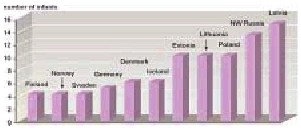
Fig 3.1 - Infant mortality rate in Baltic 21 countries
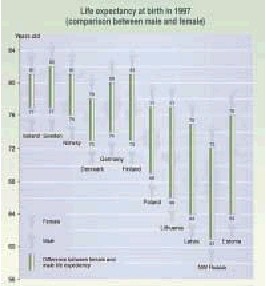
Fig 3.2 - Life Expectancy in Baltic 21 countries. For each country, the rate for women is at the top, and at the bottom for men.
Agriculture as an example
Christine Jakobsson then turned her attention to the agricultural sector and spoke of the goals for the work in this area: “Agriculture contributes significantly to the society of the future. Sustainable agriculture is the production of high-quality food and other agricultural products and services in the long run, taking into account economy and social structure in such a way that the resource base of non-renewable and renewable resources is maintained.” To achieve this important subgoal requires that:
- farmers’ income be sufficient to provide a fair standard of living in the agricultural community.
- farmers practise production methods, including biodiversity, which do not threaten human or animal health or degrade the environment, and at the same time minimise the environmental problems that future generations will have to assume responsibility for.
- non-renewable resources gradually be replaced by renewable resources, and that re-circulation of non-renewable resources be maximised.
- sustainable agriculture meets the needs of food and recreation, preserves the landscape, cultural values and historical heritage of rural areas, and contributes to the creation of stable, well-developed and secure rural communities.
- the ethical aspects of agricultural production be safeguarded.
Each of these goals has been discussed – some at great length – in order to reach workable agreements and solutions. According to Christine Jakobsson, the ethical aspects, for instance, are important to include, and she drew attention to the many cases of Mad Cow Disease and other problems with food quality.
Success criteria
In all these areas, Baltic 21 examines the direction in which developments are moving. One such indicator is the number of livestock animal per hectare in BSP countries.
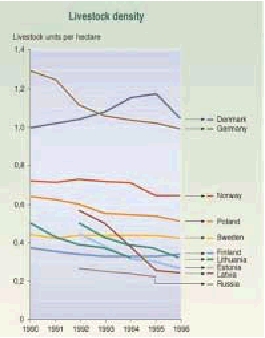
Fig 3.3 - Livestock density in Baltic 21 countries. In some countries, a steep decline took place in the years immediately following the end of the communist era.
“When we compare progress with the goals achieved, it is important to notice that political goals are not always realistic goals,” Christine Jakobsson stressed. She mentioned, for instance, that there is a goal to reduce nutrient outlet by 50%. This has not been achieved anywhere in the region, but a reduction of 25% has been reached in several places.
Overall goals and actions
According to Christine Jakobsson, the overall goals of the work in this area are:
- to build sustainable structures.
- to improve the viability of agriculture in the region.
- to strengthen farm management with respect to aspects relating to environment, biodiversi-ty, landscape, cultural heritage, social and economic issues.
- to create demonstration watersheds with training/educational programmes.
- to improve agro-environmental legislation.
To reach these goals, the following actions have been prioritised:
- Provision of education and training.
- Creation of demonstration watersheds with demonstration farms in a network in the countries.
- Development of a ”Virtual Research Institute” for sustainable agriculture
- Elaboration and implementation of agro-environmental legislation and policies.
“Education and training is the number one goal. And this goes not only for farmers. It is equally important to raise consumer awareness and to educate and inform politicians, advisors and everybody else,” Christine Jakobsson said.
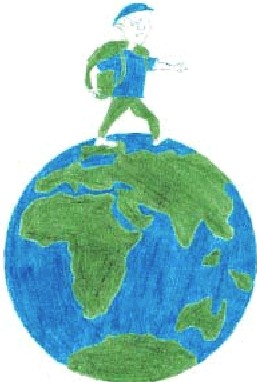
Aleksandra Pisarska, Poland
Sustainable Agriculture, Food Quality and Human Health
Lecture by Jens-Otto Andersen, Denmark
Public focus on food quality
“Normally when we walk, we do not pay attention to our legs. But when we break a leg, we suddenly realise how important the leg is and how complicated it really is to do a ’simple’ thing like walking. Today, this is the situation concerning food quality. There is tremendous public focus on food quality and many people feel that we have – so to speak - broken a leg in this area.” Those were the opening words of Jens-Otto Andersen when he gave a very pedagogical lecture to the BSP participants on the subject “Sustainable Agriculture, Food Quality and Human Health”.
His conclusion, with which he also started, is that there is a very close connection between the quality of soil, plants and human beings: “Mother Nature is extremely complex, and today we do not know enough about how she works,” he said, also warning the students not to take his words for granted: “Other researchers will paint a different picture. Think for yourself, ask questions, investigate.”
Young rabbits dying at birth
Jens-Otto Andersen told of a famous research finding in 1975 when pregnant female rabbits were fed different kinds of food. This resulted in very different death rates for the newborn young rabbits: Of the mothers fed conventional fresh food + vitamins, 50% of the newborn rabbits died. Of those only fed conventional fresh food, 51% died. But of those fed organic fresh food, only 27% died.
“These results raise a big question: Why do we see this difference? In my view, the conclusion is that there is a close connection in the way we farm, in food quality and in human health; a very close connection,” Jens-Otto Andersen said.
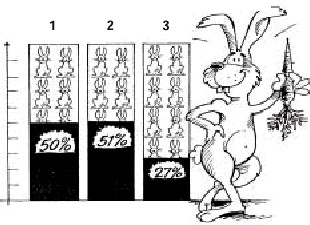
Young rabbits dying at birth:
- Conventional fresh food + vitamins
- Conventional fresh food
- Organic fresh food
Not insulting conventional agriculture
“I do not want to insult conventional agriculture as such. Conventional agriculture is many different things, just as you can find good as well as very poor examples of organic agriculture. There is a great variety in both cases,” Jens-Otto Andersen stressed.
FOOD QUALITY AND HUMAN HEALTH
Healthy plants?
He then went on to talk about healthy plants. Using wheat as an example, he showed the audience how plants become less capable of defending themselves against fungus attacks if the soil is fed too much nitrogen (fertiliser). Farmers therefore start using pesticides in order to protect the plants, thus initiating a vicious circle:
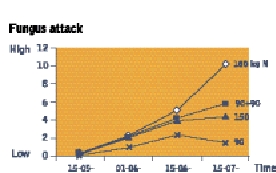
Fig 3.4 - Relationship between fungus attacks on wheat and the amount of fertiliser (kg N)
“It is quite normal in modern agriculture to use 180kg of nitrogen per hectare. Research has shown that wheat is several times more vulnerable to fungus attacks when you use this amount compared to only using 90kg. This means that the farmer always has to apply pesticides. We artificially create sickness in the plant.”
Intelligent plants
Jens-Otto Andersen went on to talk about the many components in nutrients and in plants –both primary nutrients, like minerals, carbohydrates, proteins, amino acids, fats and vitamins, and secondary nutrients, like aroma, taste, phenols, alkaloids and flavonoids – some of the latter providing human beings with protection against cancer.
“The plant can resist fungus attacks by producing a high concentration of caffeic acid. When the plant senses that a spore from a fungus has landed on a leaf, it produces so much caffeic acid in that specific area that it actually kills a small area around the spore,” Jens-Otto Andersen explained.
Healing ulcers in rats
He then told of another scientific experiment showing the importance of caffeic acid: Two groups of rats were starved for 24 hours in order to empty their stomachs. Then the rats had acid injected into their stomachs in order to create an ulcer. Afterwards, one group was fed a ginger extract with a high concentration of caf-feic acid, while the other group was not given this food. After some time, the rats were killed and dissected, and it was clear to see that the group fed caffeic acid was capable of healing the ulcer much better than the other group.
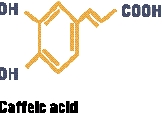
Healing of ulcer better with ginger phenols
A positive circle
Jens-Otto Andersen used this experiment to conclude that there is an important circle of inter-dependence in nature:
- Sustainable agriculture yields healthy soils.
- Healthy soils yield healthy plants.
- Healthy plants yield healthy animals and human beings.
The Greenhouse Effect and the Risk of Global Climate Change - Status 2000
Lecture by Peter Laut, Denmark
“Climate is the sum of many things: the temperature and the way it shifts during the year; rain and its distribution annually and globally; the number of hours with sunshine; the degree of cloud cover and so on. All this is climate, and each separate factor can change – and does change.”
“Many people cannot imagine any change in the climate. They are used to ’their own’ climate and think that climatic changes are something that happened 100,000 years ago. This is not true.”
Those were the opening remarks of Professor Peter Laut of the Technical University of Den-mark when he gave a very lively lecture on the greenhouse effect and the risk of global climate change, where he succeeded in explaining these sometimes very complicated and complex issues in a very pedagogical manner.
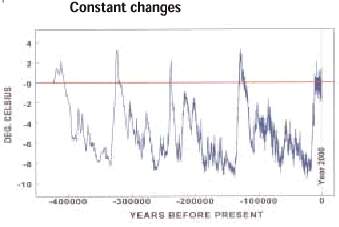
Fig 3.5 - Climate changes in the past Temperatures over Antarctica during the last 420000 years Scale: °C relative to the present
Peter Laut started by showing a graph illustrating past changes in climate and temperature over Antarctica during the last 400,000 years. One could clearly see four distinct epochs with relatively high temperatures each lasting approximately 20,000 years – and each followed by an ice age, a glacier period.
“We are now living in the 5th warm period, but this one is different from the previous because the temperature remains constant at a relatively high level,” Peter Laut explained and continued: “
All civilisations that we know of have developed within this period and therefore we all think that temperatures will be constant. NO! Stockholm will once again be covered in thousands of metres of ice,” the professor told the audience.
Many public misunderstandings
Throughout the lecture, Peter Laut took up public misconceptions about the greenhouse effect, which one hears again and again in the media or in one-on-one discussions. One of them is that ’global warming will prevent another ice age’.
“NO! This is not true: the effects of global warming will last maybe 500 years – then the ice age will come,” Peter Laut said.
Another ’public misconception’ is that nature will regulate itself and always try to return to a stable ’middle position’. But again Peter Laut said “NO! : Nature is accustomed to great changes.”
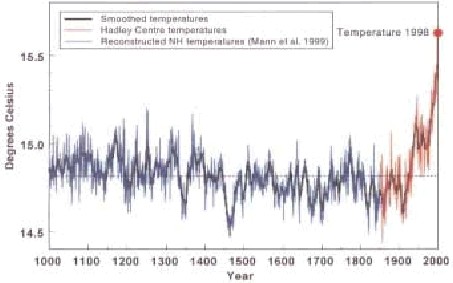
Fig 3.6 - Northern Hemisphere temperatures over the last 1,000 years.
Tempereature IS rising
Peter Laut showed a graph with the mean temperatures in the Northern Hemisphere over the last 1,000 years. The graph clearly indicates that temperatures have been rising steeply since the middle of the last century.
“Global warming during the last 100 years is between 0.4 and 0.8 degrees Centigrade. The global temperature is definitely rising,” Peter Laut concluded.
The “natural” greenhouse effect
Peter Laut then went on to tell about the natural greenhouse effect and the man-made increase in temperature. Greenhouse gases account for 0.4% of the volume of the atmosphere – but they play a crucial role in determining the temperature on Earth.
The greenhouse gases can absorb and re-emit heat radiation from the surroundings. This means that these gases absorb the heat radiation which goes up in the atmosphere, hold the gases for a little while and then re-emit them in another direction. This process goes on continuously and the result is that most heat radiation eventually returns to Earth.
The effect of this process is that the global average temperature is +15 instead of -18 – a difference of 33 degrees.

Fig 3.7 - The “natural” greenhouse effect and the man-made increase
“The amounts of greenhouse gases have been constant for 10,000 years and there is no scientific debate about the greenhouse effect in itself. It is NOT a theory. But in the last 50 years, the amounts of greenhouse gases have increased in the atmosphere. This means that more heat is being sent back to the earth, which means the temperature will rise,” Peter Laut said.
“The crucial question of course is ’how much’ it will rise. That of course is very difficult to calculate. The best scientific estimate is 2-4 degrees over the next 100 years”.
The energy budget of the Earth
Peter Laut then used another method to explain other aspects of the greenhouse effect, showing what happens to 100 units of sunshine entering the Earth’s atmosphere.
Out of 100 units, 22 units are reflected by clouds, 8 units are reflected by the Earth’s surface, 20 units are absorbed by the atmosphere, and the remaining 50 units reach the ground, where they are converted to heat.
For the temperature to remain stable, the Earth has to rid itself of these 50 units and this is done in the following way: 7 units are taken into the atmosphere by thermal winds, 23 units are absorbed by the atmosphere through evapo-transpiration, and the last 20 units leave the Earth as radiation.
The problem is that the last 20 units are made up of a balance between surface radiation eminating from the Earth and back radiation reentering the surface thanks to the mechanism of the greenhouse gases described previously. The balance maintained by the Earth’s climate system during the previous 10,000 years of stable climate has been 115 units leaving the surface and 95 re-entering, thus creating a surplus of 20 units.
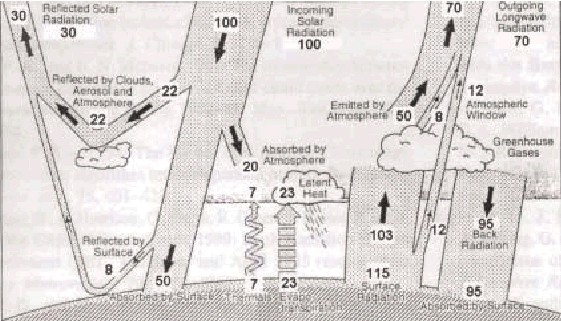
The energy budget of the Earth. Global annual mean (Unit: 3.42 W/m2)
The man-made increase in the amounts of greenhouse gases means that the amount re-entering the surface has also increased from the old equilibrium value of 95 units, causing temperatures to rise.
What will happen?
Based on current scientific knowledge, Peter Laut estimates that there will be a global warming of approximately 2-4 degrees, that the sea level will rise 0.5 metres (causing, for instance, 50% of all agricultural land in Bangladesh to disappear), and that there will be changes in rain and snow patterns.
“These last changes may be the most important,” Peter Laut said.
Rising CO2 concentration
Another public misconception is that there is no reason to worry about the rise in CO2 in the atmosphere. ’CO2 is good for the plants,’ people say.
“That is true – but what if the plants cannot grow because the rain pattern has changed?” Peter Laut asked, adding that the CO2 level in the atmosphere was rising steeply. During the last 400,000 years, the level has constantly been between 300 ppm in the warm periods and 200 ppm during the ice ages. Today, however, the level has reached 364 ppm, and all indicators point towards a further rise to a level of 700-1000 ppm within the next generation.
What should be done?
Peter Laut went on to tell about some of the important gases making up the atmosphere, where they come from and what can be done to minimise the man-made changes. His two conclusions were that it is important to reduce the emissions of greenhouse gases as much as possible, and that it is equally important to prepare ourselves for a warmer climate.
To do both things, it is important to have more international conferences like the ones in Rio and Kyoto in 1992 and 1997, respectively, and to continue to do scientific research.
“What will all this lead to in the real world?” Peter Laut asked, and pointed towards the audience:
“It is YOU – the young generation – who will have to decide many of the important questions as voters, politicians and taxpayers. YOU will also have to do most of the work as scientists, engineers, administrators and economists.
“And YOU will experience the climate change yourselves and be able to judge if we have done enough to diminish it,” Peter Laut said, concluding his lecture.
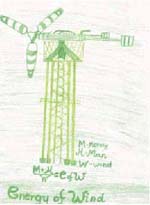
Pawel Piatek, Poland
The Global Perspective in Environmental Work
Lecture by Jakob Kjøller, Denmark
Jakob Kjøller visited Vietnam in 1998 when he worked as an intern (doing voluntary work) on a development and environmental project in Vietnam. He told about his trip, the country and first and foremost the project, showing and commenting a series of slides. This gave the BSP participants an inspiring, global angle to their work. Some of the aspects touched upon, problems discussed and facts mentioned by Jakob Kjøller are listed below.
The Hoa Binh Dam in Vietnam
Even though the environmental problems that Vietnam is facing are very different from those of European countries, and certainly of Den-mark, the solutions and the ways of dealing with the problems are sometimes the same.
In Hoa Binh on the Black River, the Viet-namese government has built the largest dam and hydropower plant in Southeast Asia. The lake stretches 230 km along the Black River and the water level has risen 60-70 m at most, leading to flooding of huge land areas. More than 58,000 people have lost their agricultural land and have had to move up into the mountains. It took five years to build the dam, which was finished in 1984. It took seven years to fill the dam, and this was completed in 1991.
When the dam was finished and the water started rising, people from the local authorities came to all the villages and put red sticks in the mountainside 50 m up. They then told people that in seven years the water would reach that level. However, people refused to believe this and moved their houses 5-10 m at a time. Many of these houses have been moved several times. Vietnamese people are relaxed and easy-going: ’Don’t worry about future problems’. They often say: ’When the water rises, wait until the water reaches your feet and then run.’
Most of the people who have had to move are ethnic minorities.
In 1993, this hydropower plant produced 45% of all the electricity produced in Vietnam. This is environmentally ’good’ energy, which does not worsen the greenhouse effect. Therefore, it is not easy to say if these dams are good or bad: They are really bad for the people who had to move, but good for the environment in other terms.
Some people moved further away from the lake and many villages are only accessible on foot, as there are no roads, no electricity, etc.
Ecological problems in Vietnam
The building of the dam also meant that more people had to live on a smaller area of land, which has increased the consumption of resources. One of the biggest problems in this part of Vietnam is that the people cut down forest in order to make a living and to cultivate the land.
Today, many people have to cultivate hillsides where there is less water for irrigation. At the same time, there is less land per person and people are not familiar with appropriate methods for cultivating sloping land nor do they have the right types of crops suitable for this land.
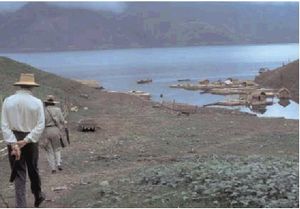
The CARE project area of the Hoa Binh Dam in Vietnam
Many people in the mountains have for generations used what is known as slash–and-burn techniques. This is actually a very sustainable method:
People burn the forest and cultivate the land for a short period of time. They then leave it for a long period while the forest regenerates. Unfortunately, when the population increases, more people have to live off the same area, and the forest is unable to regenerate.
When the soil is left bare, it leads to soil erosion. The top layers of the soil are where all the nutrients needed by the trees and vegetables are found, and when it rains, these top layers are washed away, leaving sandy and bad soil. Such areas are very difficult to cultivate again.
Soil erosion is a serious problem. It also leads to silitation of rivers and lakes, which means more flooding when it rains. Furthermore, the Hoa Binh power plant is now only expected to last for 50 years, compared to the prediction of 100 years when it was built.
Deforestation has meant that today less than 20% of Vietnam is covered by forest. In 1960, the figure was 40%. Every year an area of 2000 km2, i.e. 40 km by 50 km, is cut down.
One reason for this is the population growth, which is more than 2% a year, with 40-45% of the population in Vietnam under 15 years old. During the Vietnam War, bombs and chemicals dropped by the Americans, such as Agent Orange, also killed many trees.
Another reason is poverty. Vietnam has experienced high economic growth during the last 10 years, but this has mainly benefited people living in cities, not the 80% of the population who live in the countryside.
The CARE project
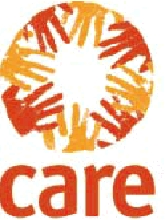 These are the problems that the CARE Denmark project in which I was involved in had to address. The importance of this is that, even though the environmental problems are very different from the ones we have in Europe, the solutions are not necessarily very different. These are the problems that the CARE Denmark project in which I was involved in had to address. The importance of this is that, even though the environmental problems are very different from the ones we have in Europe, the solutions are not necessarily very different.
The purpose of the project is to improve the environment and stop environmental degradation by giving families, households and villages a better standard of living and alternative incomes.
The local authorities in Vietnam tend to use a top-down approach. This means, for instance, that they forbid people to use or cut down the forest. The problem is that that is not a sustainable approach; at least, not in the way I define sustainable: sustainable for both people and nature. People have to be able to make a living.
To solve the problems, it is necessary to change the practices and agricultural techniques, especially of the people who used to live in the valley and cultivate rice paddy fields. The circumstances have now changed because of the dam, which means that the project also has to change.
One project activity is hedgerow planting: bushes or small trees planted in horizontal rows. They keep the soil together, which allows farmers to cultivate the soil in between on a permanent basis. This way the farmers do not have to clear new land.
In addition, the project has created some nursery gardens, and in the first six months of 1999 more than 400,000 seedlings were produced, ready to be planted.
Another good alternative is homestead gardens. The project introduces new varieties and new kinds of vegetables that are suitable for the local area and for the new circumstances. This provides an alternative to cutting down more forest.
Another good source of income is animal husbandry of different kinds: pigs, cows, bees, fishponds and chickens. The project provides new species and teaches people how to keep animals. For example, people usually have pigs roaming around free in the village. By helping people to build pigsties and breed pigs properly, it is possible to use pig manure as a natural fer-tiliser in, for example, the homestead gardens. Better husbandry also promotes better hygiene and fewer diseases.
The planting of fruit trees is another highly successful activity. Fruit trees are good because they prevent soil erosion and provide a good income.
In each village, a Village Development Board (VDB) is elected. The VDB decides how to do things and what kind of activities need to be done in each village: planting trees, building drinking-water systems, or carrying out pig vaccination campaigns. It is important to ask the people on the board what kind of activities they would they like in their village, what kind of training they feel they need, etc. This is the key to making the project participatory, and to ensuring that the project activities address the needs of the people.
Sustainable development and local competence
One of the most important aspects of development project activities is that they are sustainable. A project like this lasts for only 3-4 years in each village, after which time the activities must be able to continue by themselves.
To ensure the sustainability of the project, the people in each village set up a Village Development Fund (VDF). If a person decides, for instance, to breed pigs, he/she can borrow the money from the project to buy piglets and build fences, etc. Then after some years, when the person is able to sell the pigs, he/she has to repay this money to the VDF. This way, there is a revolving fund in the village, which can lend money out again.
In each village, model farmers are chosen by the project. They carry out the activities in a proper way; they are models for other people. The idea is that if you can get some people to do something new, and other people see that it works, it is easier to get other people to do the same.
Very often the local knowledge is available; people do not need foreigners or experts to improve everything. One model farmer, for example, took some of the tall, thick and hollow bamboo canes, cut them and made a small hole in the bottom. He then put them in the soil next to the fruit trees – and voila! He no longer needed to water them as often because the water dripped out of this bamboo cane very slowly.
For me it has been a fantastic experience and personally very rewarding to visit all these villages. And it is very personally rewarding. It is a privilege. Mostly because you feel welcome, and you actually work together with these people. I do not think that we could be more different –a student from Denmark and a farmer from Vietnam – but we worked for the same cause. Together. Especially when I said that I was an intern and not paid: That gave respect.
Beyond poverty
When you stay for four months in the same area, you start to see beyond the poverty. In the beginning, I mostly noticed the poverty, the small houses. After a while, I became used to it and started to see that people lived ordinary lives like you and me in many ways. I have experienced that behind the poverty and misery is a very strong and friendly people with an enormous vitality and energy. Vietnam is one of these countries where you just walk around in the streets and smile because people just look happy.
I think that a project like this in Vietnam shows that it is actually possible to influence things in a good and positive way. A country like Denmark spends $14 billion on development assistance every year. This is a good example because it shows that it is actually possible for us in the richer part of the world to help change things for the better in other parts.
Non-Governmental Organisations, Democracy and Action Competence
Lecture by Nanna Jordt Jørgensen, Denmark
Nanna Jordt Jørgensen, who is from Sønderborg and presently studying anthropology at the University of Copenhagen, started by presenting herself and the organisation she heads.
’Nature and Youth’. This is an environmental organisation connected to the Danish Society for the Conservation of Nature. It is open to young people between the ages of 8 and 25, and it has approximately 600 members, of whom 300-400 are active.
“In ’Nature and Youth’ we believe that if young people come out to see and experience nature, they will also want to preserve and protect it. Therefore, we try to get the youngsters involved in a lot of different activities like hiking, camping and bird watching,” Nanna Jordt Jørgensen said.
One up-coming is called ’Let’s make a bet’. ’Nature and Youth’ dares the Danish government to make a bet on whether the young generation in Denmark – by making a dedicated effort – in eight months can manage to save more CO2 than the Danish government has committed itself to doing over the next eight years.
Both idealistic and pragmatic
“Why get involved in an organisation like Nature and Youth?” Nanna Jordt Jørgensen asked.
“My own motives have changed over the years. In the beginning, I was attracted by the outdoor life and the social life. Then I got involved in environmental work, was an activist organising demonstrations, etc and tried to influence decisions. Today, I am active in international organisational work, because I found out that in order to gain influence you have to engage in other kinds of political work than just demonstrating.”
“I have learned that it requires a lot of patience to do this kind of work because you have to attend so many meetings (and hence, ironically, do not have time to go out into nature that much!). I have also learned that democracy works in many different ways, and is often not straightforward.”
“You must have goals in order to achieve anything, but you must also be pragmatic,” Nanna Jordt Jørgensen told the audience.
You CAN make a difference
“Working in an organisation like Nature and Youth gives you a great opportunity to participate in the democratic process. For me, democracy is not just voting every four or five years; democracy also means taking active part in civil society.”
“People in Denmark are often not interested in doing this. Most organisations lack members – especially active ones. Why?” Nanna Jordt Jørgensen asked and tried herself to give part of the answer:
“People do not think that their engagement makes a difference. They say that environmental problems have to be solved on an international scale and then they leave the work to the politicians. But this is not true. You CAN make a difference locally. Many campaigns start locally and end up as national and international issues,” Nanna Jordt Jørgensen said, giving an example of such a success started by her own organisation:
“Some years ago, we started to put focus on the use of pesticides in private gardens. We handed out leaflets in front of shops selling the pesticides, and we wrote letters to the newspapers and to politicians, etc. We started very locally here in Sønderborg, but today it is a national issue which is being debated in Parliament and other places.”
Lots of fun
“The Bet’, which I told about earlier, is a political campaign that will be carried out in several countries. By working internationally, your work carries more weight. Today, working internationally is necessary. It is hard work, it is time-consuming – but it is also a lot of fun. And in the end it works!” Nanna Jordt Jørgensen concluded.
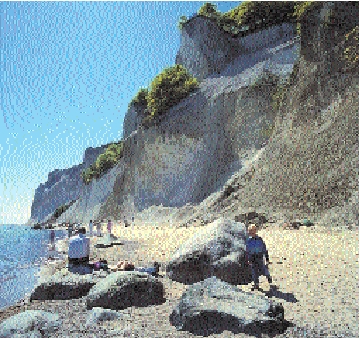
In ’Nature and Youth’ we believe that if young people come out to see and experience nature, they will also want to preserve and protect it. Møns Klint will be one of the first National Parks in Denmark.
From BSP to Municipal Youth Council
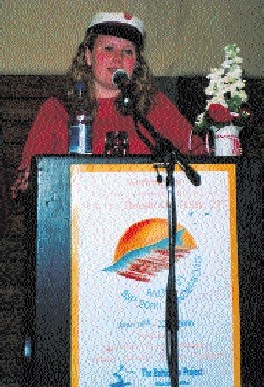
Marie Sønderborg Larsen graduated just before giving her lecture as a student from Sønderborg County High School (Amtsgymnasiet), and appeared in her white graduation cap. She attended ’the green class/ the UNESCO Baltic Sea Project class’ and became a member of Sønder-borg Youth Council. She began her lecture by telling how and why she got involved in the Municipal Youth Council:
“Our ’Green Class’ visited a school in Estonia as part of BSP networking. We were different from each other in many ways, but I especially noticed the way young people in Estonia felt about democracy, particularly their belief that they could not have any influence. This made me realise how privileged we are in Denmark. So when I came back to Sønderborg, I went to a meeting about the Youth Council, which young people had been trying to establish in the municipality for some time.”
The Youth Council consists of 15 members, five of whom are elected by all the young people in the town. Schools and organisations appoint the last 10 members.
“We prefer not to have members of the Youth Council who are also members of political parties. We want to have individual opinions and personalities that speak for themselves and other young people,” she said.
A hard start
Marie Sønderborg Larsen said that the Youth Council had a difficult beginning because the members felt that the old, ’professional’ politicians were always on their backs whenever they strayed slightly from the path of mainstream thinking.
“Today, the Youth Council works fine. We express our opinion whenever there is an issue that involves or affects the young generation in the municipality. The politicians do not always follow our suggestions, however, but we are part of the dialogue,” Marie Søndergaard Larsen said.
“The politicians do not know enough about the life of a young person today or what we experience in the streets at night when we go out to party. They have many prejudices, which influence the decisions they take.”
You need a sharp tongue
As an example of the work in the Youth Council, Marie Søndergaard Larsen mentioned the many refugees and immigrants in Sønderborg:
“We have worked together with some of the groups they have formed in order to get ’old’ and ’new’ Danes to mix more instead of heading off in two separate directions.” “I have learned to be patient. It takes a long time to get things through.”
“Politics is interesting. But the game of the old politicians is hard to play if you do not have a sharp tongue,” Marie Søndergaard Larsen told us based on some of her experiences from spending more than two years in the Youth Council. Even though it has sometimes been hard, she is happy about what she did:
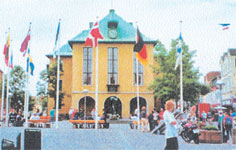
Sønderborg Town Hall
Don’t lose faith
“I would not have missed any of it, and I can only encourage all of you to do the same and to try to start a municipal youth council in your own school or town.”
When asked about what a first step in that direction should be, she answered:
“Be a group, stand together, don’t lose faith and make sure you talk to some of the politicians ahead of the first meetings.”
“Stay faithful to the idea and stick together. Then you’ll succeed.”
On Biodiversity
Lecture by Hans Henrik Bruun,Denmark
Hans Henrik Bruun lectured on biodiversity with special emphasis on what this term really means. He also used a major part of the lecture to explain various methods for determining bio-diversity in the past, thus putting a historical perspective on the environmental debate.
Ecological disaster – but for whom?
One of his points was that it is important to remember that the vertebrates (human beings and animals) only make up one group in nature –and that it is a very small group compared to insects, fungi, etc.
“It is also important to remember that when we talk about, for instance, an ecological disaster area, it may be an ecological disaster for humans and other vertebrates, but heavy metals are not necessarily dangerous for fungi or plants. As a matter of fact, when I visited an ecological disaster area in the Ural mountains in Russia, we found many fungi which are threatened with extinction in Europe to be thriving in this area, because it was a virgin forest hardly touched by human hand,” Hans Henrik Bruun said.
Big variations
He gave the audience examples of how trees like beech and spruce have spread in Europe over time and went on to show the big variation in nature in two Baltic countries of the same size: Estonia and Denmark.
What favours biodiversity?
“What circumstances favour biodiversity?” Hans Henrik Bruun asked, and highlighted the three most important:
- A mature ecosystem
- Long maturity since immigration
- Long continuity of patch of forest/grassland
“Especially the time factor is important. So if you have to make a choice, you should always choose to preserve the oldest patches of nature. This is where the greatest biodiversity is,” Hans Henrik Bruun said, concluding his lecture, which included a series of slides.


Andrius Smetona, Lithuania
Cultural Activities »Stones for Bread« at Cathrinesminde Teglværksmuseum
At Nybøl Nor, an area of glacial age deposits of clay, later to be exploited as an important resource material, lies Catrinesminde Teglværk (brickworks). The area today is part of Sønderborg Museum – the perfect setting for an outdoor performance presented as "Environmental History Theatre":
Stones for Bread
Playwright Jacob Clausen,
Director Ole Sørensen
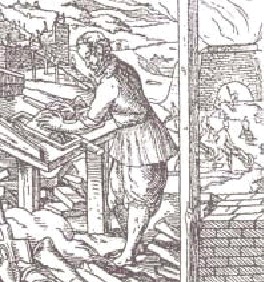
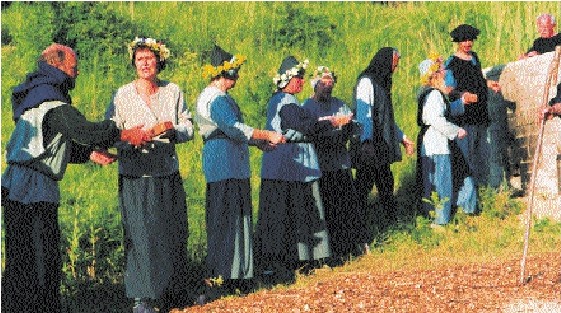
hey will get bread – if they make stone
First play - Evening
It is Walpurgis Night, Thursday 30th April 1198
A peasant village. A young girl has had a peculiar dream, a premonition of something that will change their lives. It is a dream about earth, water, wind and fire. Strangers appear in the village: the mighty master of Broagerland and the Abbot of Ryd Abbey. They bring with them a secret; the secret of how to change clay into stone. A church is to be built on the spot, and clay must be dug. A clairvoyant woman warns of devilry and misfortune.
Out of curiosity, and because of the opportunity for regular work, the peasants embrace this new concept. They will get bread – if they make stone.
Second play - Early morning
It is May Day, Friday 1st May 1545
Men and women appear from the woods. They have been dancing on Walpurgis Night.
One of the girls has put a clay figure in the kiln to be fired. She is eagerly waiting to see the result. There is dancing and storytelling. The stories concern the king, who is being kept under house arrest at the castle in Sønderborg. The lords have usurped the king’s power. Suddenly the king arrives on the scene. It is King Christian II. He is popular among the people. The lord lieutenant sends the king back to detention. Then it is back to work. The kiln must be attended to, and the girl receives her clay figure.
Third play - Morning
It is Friday 1st May 1744
The village people work and play. The overseer at the brickworks keeps watch to make sure everything is running smoothly. A couple of boys get too boisterous and race around, tipping a wheelbarrow. They get into trouble and are sent back to work. The children must attend to their duties, especially those who have already been confirmed. A cargo of Flensburg-style bricks is being loaded on board a ship. There is a shortage of bricks in Copenhagen following the great fire. Some of the bricks will be shipped out to the West Indies.
A horse-drawn cart arrives carrying bricks. On the back of the cart is a pregnant woman in labour. An argument arises between the workers and the overseer of the brickworks.
”We don’t just want to trade bricks for bread – there’s got to be a bit of happiness as well.”
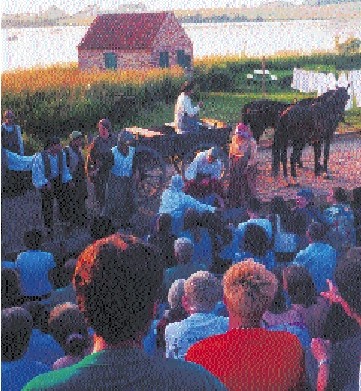
A horse-drawn cart arrives carrying bricks.
Fourth play – Midday
It is Friday 1st May 1896
The hubbub of everyday life goes on at the workers’ houses. There are children playing and women working. The men lay sleepers for the carriages. There are new machines, new kilns.
The brickworks is buzzing with life. Demands for higher wages are the order of the day. A family of newcomers arrives – to work at the brickworks.
There is a certain amount of distrust. The children are the first to make friends. There is an accident involving the children. A socialist agitator arrives and talks about rights and demands. It is 1st May. There is a stirring among the assembled throng.
Fifth play – Afternoon
It is Saturday 2nd May 1936
The new machine means that everyone must work hard and fast. More and more hands become redundant. Right now the new machine is idle, as nobody can get it to work. There are sounds of shouting and complaining. Two vagabonds turn up and lift everyone’s spirits.
They say whatever suits them. The brickworks proprietor has arrived. The old foreman is fired.
He will be replaced by a younger man who knows all about machines. A woman – the daughter of the old foreman – has been sitting throughout the play working with clay. There is talk of a dream, something that will change everything. The wheel has come full circle and everyone is united in song.
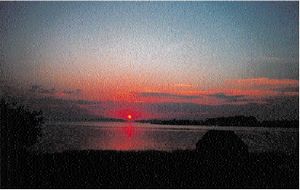
The sun sets behind the open-air theatre stage at Cathrinesminde Teglværk.
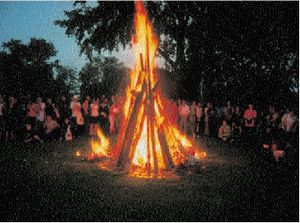
Midsummer’s Night 2000
It is 21 June and time to get rid of the witches! According to the legend Midsummer’s Night is a night with special powers. Water in holy springs cure people of their illnesses, but also evil forces are out. Witches fly on their broomsticks to Blocksbjerg, and to keep them away people light bonfires.To actually put a witch onto the fire is a tradition that started in the 18th century.
It is part of the tradition that people gather to sing. Holger Drachmann’s »Midsummer’s Night« (1885) from the comedy »Once upon a Time« is part of the tradition and of Danish culture.

Denne side indgår i publikationen "EDUCATION FOR SUSTAINABLE DEVELOPMENT" som kapitel 3 af 8
© Undervisningsministeriet 2003
|